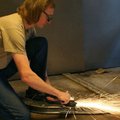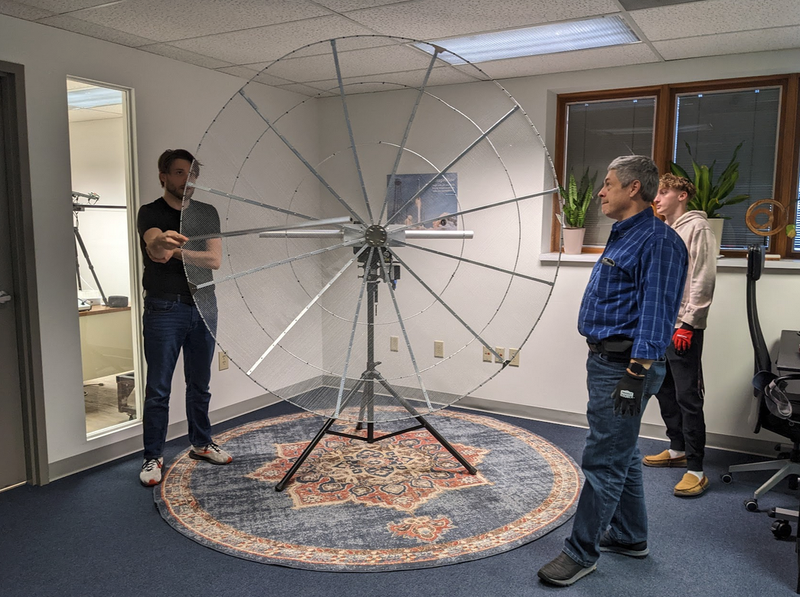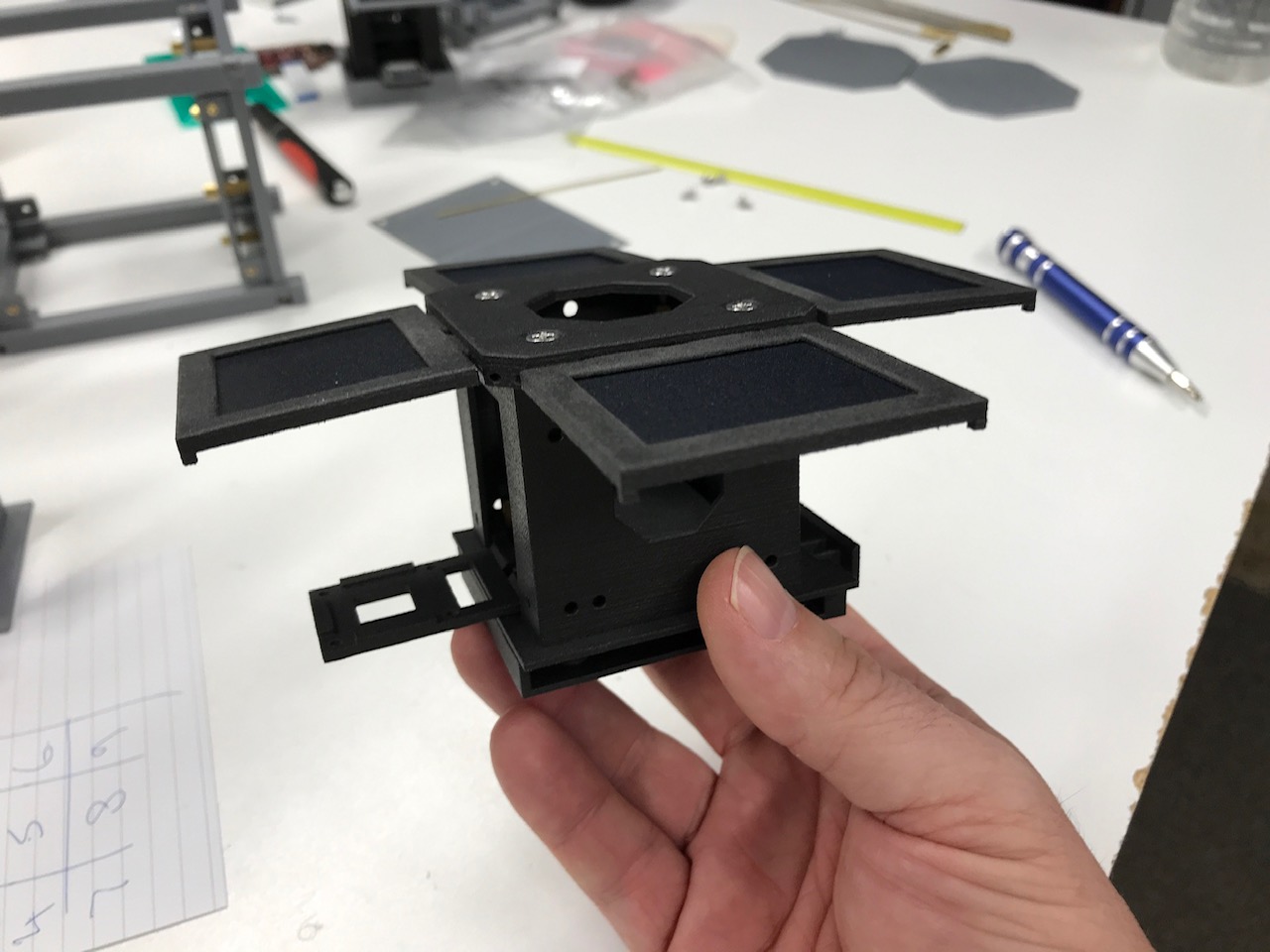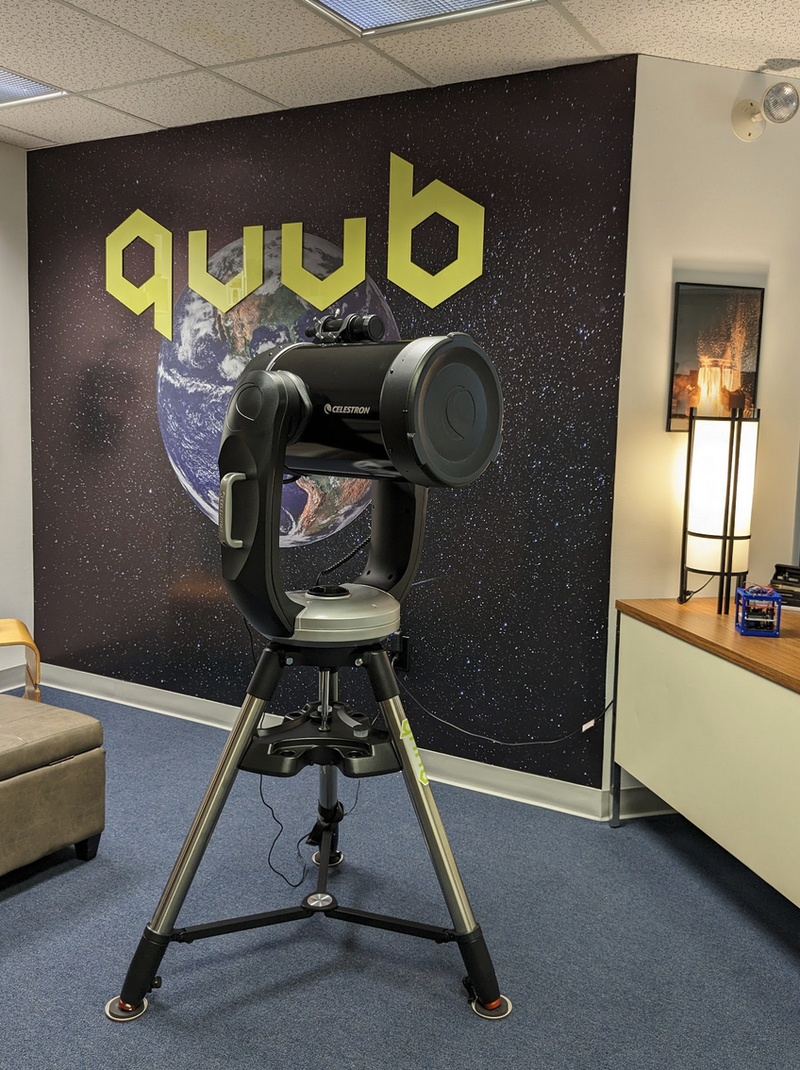 OK, let's talk satellites! I'm Dan, I'll be modding today along with Dusan for Nathaniel Evry from Quub, Inc as we talk DIY PIcosatellites. Apologies in advance for my wonky keyboard with the stuck spacebar, BTW
OK, let's talk satellites! I'm Dan, I'll be modding today along with Dusan for Nathaniel Evry from Quub, Inc as we talk DIY PIcosatellites. Apologies in advance for my wonky keyboard with the stuck spacebar, BTW
 hi
hi
 @Nathaniel@quub.space - Welcome aboard!
@Nathaniel@quub.space - Welcome aboard!
 Hi Dan
Hi Dan
 Hello and welcome everyone!
Hello and welcome everyone!
 Greetings!
Greetings!
 Hi Dule!
Hi Dule!

 @Dan Maloney Thanks!! And funny that the *space* bar is what's bugging you :p
@Dan Maloney Thanks!! And funny that the *space* bar is what's bugging you :p
 Welcome, hackers, scientists, and pioneers! I’m Nathaniel Evry, Chief Research Officer at quub, a vibrant aerospace startup pushing the boundaries of what’s possible in the sky above. My career has been a thrilling journey through various domains, from software engineering to hardware prototyping, data science to systems architecture. However, all paths converge at one destination: innovation and the continuous pursuit of knowledge.
Welcome, hackers, scientists, and pioneers! I’m Nathaniel Evry, Chief Research Officer at quub, a vibrant aerospace startup pushing the boundaries of what’s possible in the sky above. My career has been a thrilling journey through various domains, from software engineering to hardware prototyping, data science to systems architecture. However, all paths converge at one destination: innovation and the continuous pursuit of knowledge.
In my role at quub, I harness the power of these diverse skills to accomplish something truly extraordinary - building and managing a network constellation of pico-satellites. This revolutionary project is about much more than exploring the final frontier; it's about democratizing access to real-time, earth-monitoring data for everyone, everywhere.
As much as I love exploring the cosmos, I'm equally fascinated by the potential of modern artificial intelligence and Language Model development. I'm passionate about how these technologies can shape our future, and I apply them wherever possible in our work at quub, from automating satellite operations to processing the vast amounts of data our pico-satellites collect.
Outside of work, you'll find me speaking on a variety of topics like AI and Space, deeply involved in the Lancaster Open Source Community, racing high-speed FPV drones, or working on 3D printed prosthetic hands for kids as part of a project that has allowed me to put the magic of technology in the hands of those who need it most.
Today, I invite you to join me in a discussion about DIY picosatellites, the challenges they present, their potential, and the crossroads where space exploration meets AI and Language Model development. Let's unlock the mysteries of the universe together, one hack at a time!
 Ask me. Anything
Ask me. Anything
*braces for impact*
 Can you define a picosat (say vs a nanosat, &c)?
Can you define a picosat (say vs a nanosat, &c)?
 Shields up?
Shields up?
 What sensors do you have on board and how do you communicate with the satellites?
What sensors do you have on board and how do you communicate with the satellites?

![]() Are any educational institutions involved in your picosat project?
Are any educational institutions involved in your picosat project?
 Would picosat's have the ability to time share? Could someone pay for slices of time on the picosats without having to commit to a large expense of owning a sat in the constellation?
Would picosat's have the ability to time share? Could someone pay for slices of time on the picosats without having to commit to a large expense of owning a sat in the constellation?
 @Dag Spicer Sure! The naming convention is mostly related to the sizes and weights.
@Dag Spicer Sure! The naming convention is mostly related to the sizes and weights.
NASA's page Minisatellite, 100-180 kilograms: https://www.nasa.gov/content/what-are-smallsats-and-cubesats
Microsatellite, 10-100 kilograms
Nanosatellite, 1-10 kilograms
Picosatellite, 0.01-1 kilograms
Femtosatellite, 0.001-0.01 kilograms
But mostly we think of it in terms of SIZE. Our primary platform is a "6p Pocketqube" That is only ~50mm x 100mm x 200mm
 What is your personal best picosat in orbit?
What is your personal best picosat in orbit?

 hm isn't this a "8p pocketcube", a pocketcube being 50mm x 50mm x 50mm?
hm isn't this a "8p pocketcube", a pocketcube being 50mm x 50mm x 50mm?
 @hkurz We work on Earth Observation using Optical Cameras, IR, SAR
@hkurz We work on Earth Observation using Optical Cameras, IR, SAR
The craft needs motion sensing, deployment of solar panel sensing, voltage, and more. We focus on modularity to add new and interesting experiments without much fuss through the RP2040 pi pico :)
 @Nathaniel@quub.space are you using a RTOS on the RP2040?
@Nathaniel@quub.space are you using a RTOS on the RP2040?
 @Norbert Heinz This one at 1:31 coming out of the deployer 😎
@Norbert Heinz This one at 1:31 coming out of the deployer 😎

 Do you have 1x base station on earth for receiving/transmitting or..? And what type of RF modulation do you use? And what power?
Do you have 1x base station on earth for receiving/transmitting or..? And what type of RF modulation do you use? And what power?
 @hkurz each "p" is 5x5x5cm https://en.wikipedia.org/wiki/PocketQube
@hkurz each "p" is 5x5x5cm https://en.wikipedia.org/wiki/PocketQube
We submitted an addendum to the official standard for a 2x3 form factor to get some extra internal space and surface area
 And nope, no RTOS needed in our ops. We work with a lot of just-in-time compute.
And nope, no RTOS needed in our ops. We work with a lot of just-in-time compute.
As of yet, we are able to work with the official Pi foundation Guidelines for micropython and C programming alone.
 What's the purpose of that box deployed into orbit? The short video sequence doesn't give me a hint. Looks like it was shot back to earth ;-)
What's the purpose of that box deployed into orbit? The short video sequence doesn't give me a hint. Looks like it was shot back to earth ;-)
![]() How do you find the kind of problems that picosats are best at solving?
How do you find the kind of problems that picosats are best at solving?
 On which frequencies are you communicating, and are you using LORA or other new RF modulations? Background, i have a "tinygs" Groundstations which can receive several sats with minimal effort via LORA (https://tinygs.com/)
On which frequencies are you communicating, and are you using LORA or other new RF modulations? Background, i have a "tinygs" Groundstations which can receive several sats with minimal effort via LORA (https://tinygs.com/)


![]() Assuming the radio transmissions can be monitored from ground, will orbital elements be published?
Assuming the radio transmissions can be monitored from ground, will orbital elements be published?
 @anfractuosity Right now we're mostly focused on S band. We have our own dish, a secondary ground station, and we work with partners like AWS for global coverage.
@anfractuosity Right now we're mostly focused on S band. We have our own dish, a secondary ground station, and we work with partners like AWS for global coverage.
 oh neat, i had heard of that AWS service for sats before, but couldn't seem to find a lot of info on it, like price etc
oh neat, i had heard of that AWS service for sats before, but couldn't seem to find a lot of info on it, like price etc
 oh its says now - https://aws.amazon.com/ground-station/pricing/ :)
oh its says now - https://aws.amazon.com/ground-station/pricing/ :)
 @Norbert Heinz hah, fair. That's the Firefly Alpha mission where we worked with Teachers in Space (@vincent.e.leveque yes we do work with a few!)
@Norbert Heinz hah, fair. That's the Firefly Alpha mission where we worked with Teachers in Space (@vincent.e.leveque yes we do work with a few!)
We heard back initial telemetry from this 3U cubesat (Serenity 2) and it did indeed re-enter the atmosphere already.
 is your hardware/software open source?
is your hardware/software open source?
 @Boian Mitov one of the many fancy things we do. We are using one of the all-time smallest ion thruster systems having partnered with Applied Ion Systems https://twitter.com/Applied_Ion
@Boian Mitov one of the many fancy things we do. We are using one of the all-time smallest ion thruster systems having partnered with Applied Ion Systems https://twitter.com/Applied_Ion
But yes, this is a complicated problem. There are several companies and many organizations that track all the stuff up there. We are able to get some advanced notice, but in order to prevent contributing to the problem one of our main goals is to not leave our stuff up there when we are done.
 I'm curious what you use camera wise, i assume you used a manual focus lens? Can you say what camera module you use? Also have you ever had any problems with bit-flips, and do you try to mitigate that?
I'm curious what you use camera wise, i assume you used a manual focus lens? Can you say what camera module you use? Also have you ever had any problems with bit-flips, and do you try to mitigate that?
 > Are any educational institutions involved in your picosat project?
> Are any educational institutions involved in your picosat project?
@Boian Mitov In our case we are working at the bleeding edge of digitali satellite design.
What can't you do with a Linux machine in space? They're going to be used for everything from space mining, to communications!
 @anfractuosity On some projects, we have operated in amateur and scientific bands (~400mhz) and more recently, up in the S-Band.
@anfractuosity On some projects, we have operated in amateur and scientific bands (~400mhz) and more recently, up in the S-Band.
We've not needed more than BPSK via a SDR for our data rates and goals.
 What's the power budget of your sat? (solar cells, power usage of main components)
What's the power budget of your sat? (solar cells, power usage of main components)

 > Assuming the radio transmissions can be monitored from ground, will orbital elements be published?
> Assuming the radio transmissions can be monitored from ground, will orbital elements be published?
@vincent.e.leveque Depends, which elements? Our goal to providing more access to more industry, scientists, and educators at 15 minute intervals.
 Sees "space mining", instantly thinks, "What, Bitcoin?" Then realizes that's maybe not such a bad idea
Sees "space mining", instantly thinks, "What, Bitcoin?" Then realizes that's maybe not such a bad idea
![]() Hi Nathaniel,
Hi Nathaniel,
What type of gnss do you guys use, are there any commercial gnss that have no limit (ITAR/COCOM) till 100km altitude?
 > is your hardware/software open source?
> is your hardware/software open source?
@hkurz We've released some of the initial stuff about our platform and techniques. https://github.com/quubspace/SpaceHeX
Our goal is to fully open source prior generation versions of nearly all of our tech.


 looks cool :-)
looks cool :-)
1, our current camera: https://www.raspberrypi.com/products/raspberry-pi-high-quality-camera/, The lens is currently a bit of secret sauce, but I CAN say that we're excited to talk about it soon :)
2. We aren't using low level analog circuitry that is as heavily sensitive, but radiation sickness is a concern for our poor craft. Stateless reboots to a Read-Only OS work wonders.
 Are you using rad-hard/space certified parts or is this all off-the-shelf consumer hardware?
Are you using rad-hard/space certified parts or is this all off-the-shelf consumer hardware?
 I assume rad-hardened components are price prohibitive
I assume rad-hardened components are price prohibitive
 Cool, if you're using a pi camera, are you using a raspberry pi too?
Cool, if you're using a pi camera, are you using a raspberry pi too?
 Oops, bad timing -- that was directed at @Nathaniel@quub.space. I'm not speaking with authority, just conjecture
Oops, bad timing -- that was directed at @Nathaniel@quub.space. I'm not speaking with authority, just conjecture
![]() Can rad hard be tested in terrestrial conditions without a reactor or hard to get isotopes? Xray machine could hint? Or appliedscience's class accelerator (see his youtube channel)?
Can rad hard be tested in terrestrial conditions without a reactor or hard to get isotopes? Xray machine could hint? Or appliedscience's class accelerator (see his youtube channel)?
 > Sees "space mining", instantly thinks, "What, Bitcoin?" Then realizes that's maybe not such a bad idea
> Sees "space mining", instantly thinks, "What, Bitcoin?" Then realizes that's maybe not such a bad idea
@Dan Maloney We partnered with Villanova University to do exactly that. The launch on Firefly was to test quite a few things actually!
And as someone else asked, "time sharing" It's not uncommon to have multiple blades or units assigned in a sat for differing experiments. To my knowledge, we are the first company to do so with *Software* payloads too.
![]() Timesharing for sats can be done terrestrial-end too. I heard about weather radars that can spend part time tracking satellites and talking with them instead of boringly scanning the sky around and around.
Timesharing for sats can be done terrestrial-end too. I heard about weather radars that can spend part time tracking satellites and talking with them instead of boringly scanning the sky around and around.

 @Raum Ah, that is one of the few components that we do indeed very special chips to do.
@Raum Ah, that is one of the few components that we do indeed very special chips to do.
We are relying on GPS and our own computed TLEs in combination communication timing to determine positioning.
We're aiming at 400km height. And for that extra mixed-units headache, that's 17,900 Miles-per-hour in orbit!
 > Cool, if you're using a pi camera, are you using a raspberry pi too?
> Cool, if you're using a pi camera, are you using a raspberry pi too?
@anfractuosity you got it ;)
![]() What and how can be tested on the ground for the satellites? Any special concerns for shielding? Vibrations, especially during launch? Thermal considerations? Outgassing of materials?
What and how can be tested on the ground for the satellites? Any special concerns for shielding? Vibrations, especially during launch? Thermal considerations? Outgassing of materials?
 100% of our prototyping has been Consumer grade parts. Our on-ground satellite analogs can be (mostly) built out of stuff from Micro Center or Fry's
100% of our prototyping has been Consumer grade parts. Our on-ground satellite analogs can be (mostly) built out of stuff from Micro Center or Fry's
Yeah, when we get into rad-hardened tech and the extra-spicy special solar panels or the it starts to get less available to the typical consumer. But, Our frames are still 3D printed :)
![]() There are software-defined radio receiver front ends for GPS/GNSS. What is ITAR-castrated in off the shelf hardware is done in software. Is the computing (and electrical and thermal) footprint of this prohibitive?
There are software-defined radio receiver front ends for GPS/GNSS. What is ITAR-castrated in off the shelf hardware is done in software. Is the computing (and electrical and thermal) footprint of this prohibitive?
![]() 3d printed, from what materials?
3d printed, from what materials?
 Hah, @Thomas Shaddack great questions. Gimme a sec
Hah, @Thomas Shaddack great questions. Gimme a sec
 This SDR is very. very powerful and also very very tiny (exactly on brand for us at Quub) https://limemicro.com/products/boards/limesdr-mini/
This SDR is very. very powerful and also very very tiny (exactly on brand for us at Quub) https://limemicro.com/products/boards/limesdr-mini/
We've moved on to other models, but most of what we do can be picked up by a simple RTL-SDR setup.
 > What and how can be tested on the ground for the satellites? Any special concerns for shielding? Vibrations, especially during launch? Thermal considerations? Outgassing of materials?
> What and how can be tested on the ground for the satellites? Any special concerns for shielding? Vibrations, especially during launch? Thermal considerations? Outgassing of materials?
Yes.
But more seriously? We do a LOT of testing and experimenting in-house. We have a vacuum bake-out chamber that our CEO Joe Latrell built himself to cover temperature and meet outgassing requirements
![]() I saw even picosat downlinks via LoRa.
I saw even picosat downlinks via LoRa.
 SIlly question, looking at that SDR -- do you plug things together with USB cables in the satellite, or is there a more robust way of connecting modules?
SIlly question, looking at that SDR -- do you plug things together with USB cables in the satellite, or is there a more robust way of connecting modules?

3D PRINTING INDUSTRY ADA SHAIKHNAG
Mini-Cubes successful in 3D printing flight-ready mini satellites
Miniature satellite manufacturer Mini-Cubes, with the help of 3D printing service provider CRP USA, has developed and produced three 3D printed, flight-ready PocketQubes. The satellites were manufactu
Read this on 3D Printing Industry
![]() Will there be docs for that chamber? A miniaturized version can be handy for a LOT of vacuum-related assemblies. Similarly, printable materials can be potentially used for terrestrial vacuum tech. (PEI? PEEK? PVDF? How do they behave, how much they outgas, can they be baked out?)
Will there be docs for that chamber? A miniaturized version can be handy for a LOT of vacuum-related assemblies. Similarly, printable materials can be potentially used for terrestrial vacuum tech. (PEI? PEEK? PVDF? How do they behave, how much they outgas, can they be baked out?)
 This was the first-ever fully laser-sintered sat frame. And that's Joe Latrell's hand
This was the first-ever fully laser-sintered sat frame. And that's Joe Latrell's hand




 For scale, (our display model of the sat)
For scale, (our display model of the sat)

![]() Is it a good idea to solder the wire harnesses instead of using connectors?
Is it a good idea to solder the wire harnesses instead of using connectors?
 > With all those connectors and stuff, how does it cope with the Gs during the launch?
> With all those connectors and stuff, how does it cope with the Gs during the launch?
A lot of Epoxy. lol.
In our modern constructions we aim for as few to zero wires as possible. Where we can't do that we are working with some higher-grade will-not-let-go connectors. I'm not quite yet allowed to talk about that partner directly 🤫

![]() How do you get heat out of the electronics? May be rather difficult in vacuum. Also, heating from the sun, how it is handled?
How do you get heat out of the electronics? May be rather difficult in vacuum. Also, heating from the sun, how it is handled?
 How do you make the satelite point towards the earth?
How do you make the satelite point towards the earth?
 @Thomas Shaddack In short, most plastic turns to dust in the wild temperature ranges out there including PEEK.
@Thomas Shaddack In short, most plastic turns to dust in the wild temperature ranges out there including PEEK.
I'm not certain we'll be working to open source that one, it's the size of a clothes dryer and a little cost prohibitive to build. But, I'll add it to the list!
![]() It's so niche application that even just hints for the chamber and design modules will be worth gold. Everybody's use case will require different sizes and details...
It's so niche application that even just hints for the chamber and design modules will be worth gold. Everybody's use case will require different sizes and details...
 > SIlly question, looking at that SDR -- do you plug things together with USB cables in the satellite, or is there a more robust way of connecting modules?
> SIlly question, looking at that SDR -- do you plug things together with USB cables in the satellite, or is there a more robust way of connecting modules?
@Dan Maloney what's wrong with USB? 😛 If there's room, and the cables aren't accidental antenna, and (there's a lot of ands)
But really, what's the difference between this and pin headers for SPI or i2c?
 > Is it a good idea to solder the wire harnesses instead of using connectors?
> Is it a good idea to solder the wire harnesses instead of using connectors?
Depends on what frequency signals your working with across those lines.
For instance, don't solder ethernet it needs coils and shielding.
 Fair enough. I guess I just pictured everything tacked to a PCB and use traces rather than have wires or cables that could be dislodged by launch forces
Fair enough. I guess I just pictured everything tacked to a PCB and use traces rather than have wires or cables that could be dislodged by launch forces
![]() Ethernet can be coupled even via capacitors. It's dirty and I'd not use it with long wire runs. For few inches of wiring within the same general power domain it may work.
Ethernet can be coupled even via capacitors. It's dirty and I'd not use it with long wire runs. For few inches of wiring within the same general power domain it may work.
 > How do you make the satelite point towards the earth?
> How do you make the satelite point towards the earth?
@anfractuosity in the case of our Aurora Class 6p, active control systems like micro-reaction wheels and magnetorquers.
On that 1p above, Discovery, that's the funny thing. You Don't. Gravity still works up in space. If the bottom side is just a "little" bit heavier, the work is done for you,
 Dan Maloney
Dan Maloney
Discussions
Become a Hackaday.io Member
Create an account to leave a comment. Already have an account? Log In.